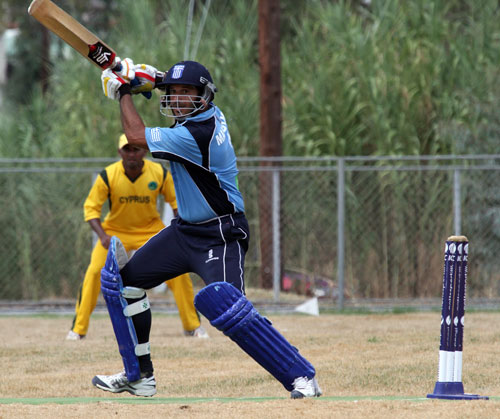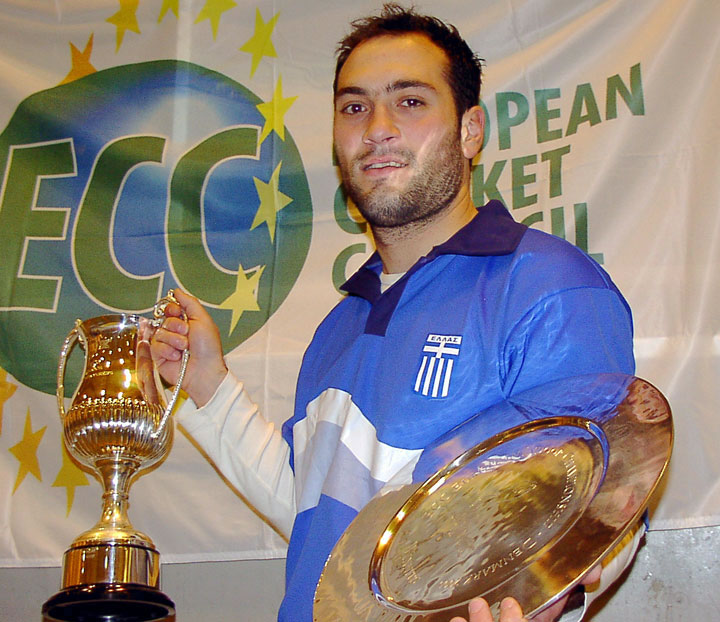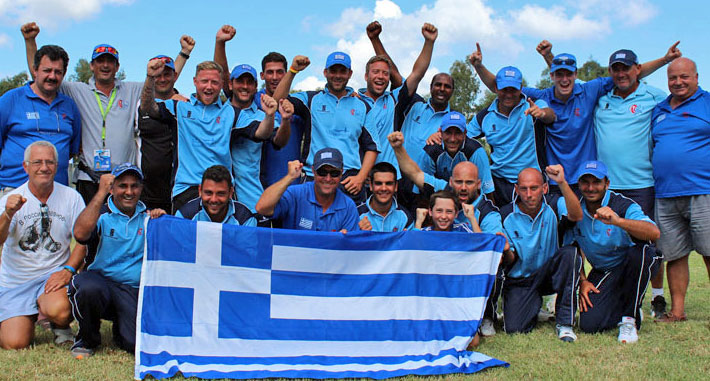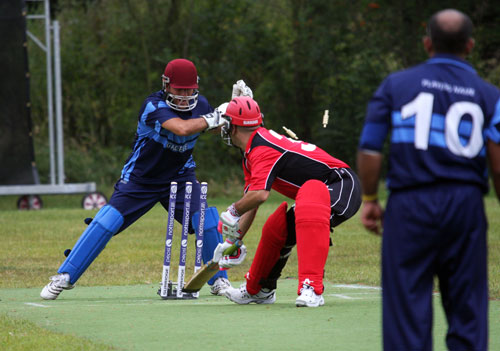The British garrison were probably playing cricket on Corfu shortly after they had taken over the island from the French in 1814 following the defeat of Napoleon at the battle of Leipzig. In his memoirs with the 32nd Foot, Major HR Lewin refers to cricket being played on the Esplanade in Corfu Town in 1823.
The matches between the Garrison and the crews of passing British ships were undoubtedly watched by the local population. What exactly encouraged them to try the game for themselves will probably never be understood but by 1835 two local clubs were in existence, the Megaloi (Big) Team, consisting of members of the nobility and well-to-do, and the Microi (Small) Team, drawn from the rest of the population, though it is likely this comprised artisans and other reasonably well-educated people rather than farmers and labourers.
 The Greek squad at the 2012 European Championships in Corfu
The Greek squad at the 2012 European Championships in Corfu
The birth of Greek cricket therefore took place in the 1830s in Corfu, well before the local inhabitants of many better-known cricketing countries had been introduced to the game. The game first played on Corfu was therefore one where curved bats were still in use and most bowling was underarm. The local sides played each other and organized matches against The Garrison, the Royal Navy, and teams made up of foreign residents. The games against visiting teams were important since they gradually introduced to Corfoit cricket round-arm and later, over-arm bowling.
By the time the British left when the island was handed over to Greece in 1864, cricket was well established among the local population. Matches between the Megaloi and Microi continued and games were regularly organized against visiting ships of the Mediterranean Fleet. The Megaloi Team evolved into two clubs, the Gongakis Company and the Kamvisis Club. But by the 1890s, the number of active players in Corfu had decreased so that it was necessary to merge the clubs into one, the Gymnastikos, formed in 1893 to widen the membership. Matches were now confined to occasional games against ships of the Royal Navy. The ground at the Esplanade was allowed to deteriorate with the grass giving way to a surface of bare earth liberally sprinkled with stones. Sufficient interest was retained to organize an annual cricket festival.
After the First World War, cricket underwent a revival. In 1923, the Ergatikos (Artisans) Club was formed, taking over the mantle of the Microi. In 1930 it was renamed the Byron Club and membership was opened to the aristocracy. Since that time, there has been intense rivalry between the two. Otherwise cricket between the two World Wars continued as before with matches against the Mediterranean Fleet, usually during the cricket week, being the only external contacts.
The Second World War nearly saw the demise of cricket on the island as it was occupied first by the Italians, then the Germans. Although the cricket ground escaped damage, all equipment was destroyed and few players remained. Fortunately, among the British Military Mission which arrived in 1946 were Majors George Laing and Guy Thorneycroft, two keen army cricketers, who organized equipment and started coaching sessions. The cricket revival was short-lived however because with the worsening relations between Great Britain and Greece over Cyprus in the late 1950s visits of the Fleet were suspended.
Another rescue act was needed. It came through Major John Forte, the British Vice-Counsel in Corfu, who set up an appeal through readers of the Daily Telegraph to save cricket on the island. The appeal raised £400 worth of equipment and enough publicity to establish Corfu as a suitable touring venue for British clubs. Ron Roberts included it in its itinerary in 1962 for his world tour with a star-studded international side of Test cricketers. By 1966 as many as seventeen different teams from Britain were visiting each season.
 Greece v Cyprus 2012: Runs for Anastasios Manousis
Greece v Cyprus 2012: Runs for Anastasios Manousis
The Anglo-Corfoit Cricket Association was founded in 1970 with the remit of encouraging cricket on the island. This was later reformed into the Corfu Cricket Technical Committee which became a member of the Greek Federation for Amateur Sport (SEGAS), thereby securing government funding from the Greek Ministry of Sport.
Greece took part in the European Cricketer Cup in Guernsey in 1990, winning two out of their five games, and then participated regularly in the European Nations Cup organized by the European Cricket Federation. In 1996 the Hellenic Cricket Federation was formed with responsibility for cricket throughout Greece. The national side was no longer all Greek but included a new generation of players of Asian origin, based in Athens.
They hosted the ECC Trophy in 1999 winning all five matches to collect the trophy. An unbeaten 121 from Sadiq Mehmood saw them beat Belgium, while he hit 65 in victory against Austria. He showed his all-round ability with four wickets over Switzerland, with Gerasimos also taking four scalps. Further half centuries followed by Mehmood in the semi-final against Sweden and in a nine-wicket victory against Portugal.
Greece aka Hellas Squad: Ilies Dapnis, Stamatis Aulonitis Gerasimos, John Pigis, Georgie Pigis, Nikolaos Pangalis, George Stogiannos, Vasilios Augerinos, Costas Vassilas, Safdar Ali, Sadiq Mehmood, Ali Zubair Asif, Mohammad Aslam.
The tournament win saw them playing in Division Two in Glasgow in 2000, but they found the step up arduous, losing all five matches heavily. Sajjad Anjum did take five wickets though in the 109-run loss against Portugal and scored 46 in their defeat by Israel.
The finished fifth in the ten team ECC Trophy in Austria in 2001, with the highlight being Mehmood’s 150 against Croatia in a Greece total of 306 for 5. He was in the runs again in 2003 as Greece finished fourth. His unbeaten 132 saw them post their highest total – 377 in a huge 325-run win against Luxembourg.
They proved very adept at the indoor format of the game, winning both the 2002 and 2005 European indoor tournaments.
 Winning Greek George Stogiannos at the 2005 European Indoor Championships in Herning, Denmark
Winning Greek George Stogiannos at the 2005 European Indoor Championships in Herning, Denmark
They played in the 2005 Affiliates tournament in Belgium where they finished second behind winners Norway. Stavros Nikitaras was the leading wicket taker (15), while Mehmood Ahmed took a five wicket haul as they beat Belgium. However, questions were starting to be asked about the eligibility of some of both sides players, and this was to continue the following year when having gained promotion, both sides travelled to Scotland for the Division Two competition.
Having won their three group games, Greece were deemed by ICC to have fielded two ineligible players and had their points deducted. The duo, Michail Poussis and Paul Maraziotis, were immediately suspended until the end of the competition. Greece opted not to play a relegation play-off match against Israel – being held at RAF Lossiemouth due to protests in Glasgow against the Israelis – and were subsequently relegated.
They found themselves in Division Five in 2009, which they hosted in Corfu, and triumphed winning all five matches, beating Sweden, Czech Republic, Estonia, Bulgaria and Turkey. Mehmood Ahmed was their top run scorer (184) while he also took ten wickets and along with Imran Haider shared the only century stand of the tournament – 113 versus Estonia. Spyridon Goustis was second overall in the bowling charts with 15, including five-wicket performances against Estonia and Turkey.
 Celebrations after a victory over Cyprus in 2012 (© CricketEurope)
Celebrations after a victory over Cyprus in 2012 (© CricketEurope)
They were up in Division Two in 2011 which was held in Belgium, where they finished sixth. Their only win in the group stages was against Malta, while in the play-offs they beat Finland before losing to Spain. The following year they were once again in tier two, which they were hosting. Stage fright saw them losing their opening two group games against Isle of Man and Sweden, before finishing strongly beating Croatia, Finland and Cyprus. In the play-offs they continued their form beating Estonia and Finland. Aslam Mohammad (237) was their leading scorer, while Dimitrios Triantafillidis (12) was their leading wicket taker. Their squad contained South African ODI cricketer Nic Pothas who enjoyed a successful cricket career with Hampshire as a Kolpak player.
 Greece v Malta 2011: Sharp stumping by Christos Molinaris
Greece v Malta 2011: Sharp stumping by Christos Molinaris
In the 2014 Division Three tournament in La Manga, they won and lost two games, beating Israel and Finland – skipper Anastasios Manousis making an unbeaten 102 – while losing to Belgium and Spain.
This was to be their last involvement with official ICC European competitions, although they have still been active. They played Macedonia and Bulgaria for the Balkan Cup in 2015, while in June 2018 they hosted the ‘Euro T20 Cricket League’ playing Russia, Romania, Bulgaria and Turkey twice for a total of eight games in nine days.
In 2019 they played Serbia and Bulgaria (twice) in the Hellenic Premier League, with their match against the Serbs – which they won by ten wickets after dismissing them for just 52 – being their first T20I.

